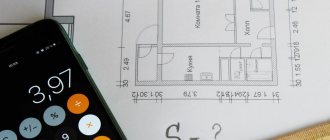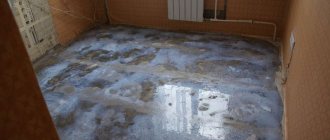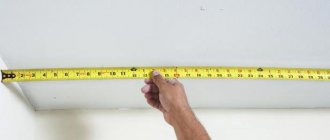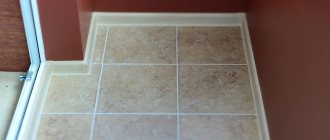Any work related to renovation of an apartment begins with choosing the design of the room and selecting the necessary materials to bring the idea to life. Next, you need to calculate the required amount of paint, wallpaper and everything else that may be useful. Sometimes novice craftsmen have a very important question - how to calculate the tiles for the floor? Let's figure out how this is done.
How to calculate tiles for the floor
Laying ceramic tiles
Calculation methods
Using a calculator will make the calculations much faster, but the results may be somewhat inaccurate. Therefore, when buying expensive luxury tiles, it is better to independently check the result obtained on the calculator.
Before starting the calculation, you need to determine:
- layout type;
- tile colors and their quantity;
- the need to use decorative elements;
- the presence of a pattern to which the material will need to be adjusted;
- tile size.
Calculation of tiles in a showroom
The easiest way to resolve any issue is to entrust it to professionals.
Moreover, in our store-salon KapRemont.rf on Rubinshteina 8 this service is provided free of charge.
zYou just need to choose the collection of ceramic tiles you like and our specialists will immediately calculate the necessary materials, paying attention to the features of the room and taking into account the number of tiles that will have to be divided into fragments (for example, in the area of the heated towel rail). In addition to the tile calculation itself, you can sign up for an interior design project with viewing in Virtual Reality to see with your own eyes what your bathroom will look like after renovation
We are always waiting for you at the address: st. Rubinshteina, 8, of. 19
In addition to the tile calculation itself, you can sign up for
an interior design project with viewing in Virtual Reality to see with your own eyes what your bathroom will look like after renovation. We are always waiting for you at the address: st. Rubinshteina, 8, of. 19.
Layout type
There are three layout options:
- Classical.
The room is divided horizontally into two parts. They are separated by a border and differ in color. The lower part is usually made dark, and the upper part lighter.
Classic layout Source profiplitka.ru
- Plain.
Tiles of the same color are used. As a rule, the presence of decor is assumed.
Plain layout Source eto-vannaya.club
- Combined.
For the layout, tiles of several colors are selected, most often three.
Combined layout Source otdelkino.ru
Valuable advice
- It should be noted that small tiles will look appropriate in a small room.
- With a low ceiling, tiles of an elongated vertical shape will visually increase the height.
- In order to eliminate the possibility of slipping on a wet floor in the bathroom, you need to choose tiles with relief.
- It is a good idea to check the perpendicularity of the walls before laying the material. Otherwise, the laid tiles will highlight all the imperfections and require a large consumption of glue, which will affect the amount of money spent.
Method of calculation using a calculator
To calculate tiles for a room using a calculator, you must enter the following data:
- room parameters;
- the area of the door, which should be subtracted from the total area;
- dimensions of the bathtub, the need to line the ends and floor under the bathtub;
- dimensions of one element;
- the required reserve is best if it is 5-10 percent.
See also: Catalog of companies that specialize in finishing materials and related work
What features need to be taken into account when making calculations
Area is not the only indicator that affects the number of tiles. There are several important points that the apartment owner should know:
- Material consumption depends on the installation method used during the work process. When finishing, they can use the direct or diagonal method.
- From the total area of the room you need to subtract the space that does not require finishing. For example, in a room you don’t have to lay tiles under a cast-iron bathtub or furniture.
- Overuse of tiles may be due to manufacturing defects or the need for trimming.
The brittle material can crack or break in the wrong place at any time. During the installation process, specialists have to ensure that the drawings match. The situation is complicated by the presence of uneven walls and ledges.
Calculating tiles without a calculator
The amount of ceramics must be calculated manually in the following order:
- Measure the parameters of the walls. If you are going to cover the bathroom screen, you need to find out its dimensions.
- Calculate the area of laying ceramics.
- Subtract from it the dimensions of the door, window, bathtub.
- Calculate the area of one tile.
- Divide the coverage area by the area of one element.
- Take into account the presence of borders and decor. Subtract them.
- If tiles of different colors are used for cladding, it is better to calculate the required material according to the sketch.
Add a margin of 5 - 10 percent. It will be needed if any part of the tile turns out to be defective or damaged during the installation process.
The tiles under the bathroom are not visible Source livemaster.ru
Advice! The part of the floor located under the bathroom can be ignored when calculating the required amount of material. The lack of coating will not be noticeable, but you can save money when buying ceramics.
Calculation of plastic corners
The use of such corners speeds up the process of laying tiles and allows you to hide small errors made during measuring or cutting tiles. They are installed in internal and external corners, at the junction of the wall and the floor. They have different colors and sizes, and are sold in standard lengths of 2 m and 4 m. They are easy to work with, one side is laid with adhesive under the tiles, and the edges go into the other side freely. This allows you to hide cut irregularities, small chips, etc.
Corner for tiles in the bathroom
Plastic and metal trim corners for tiles
Count the internal angles and measure their total length. Do the same with external ones. There is no need to round anything, the store will sell a standard length. These elements cost pennies, and you won’t be able to save money on them. Do the same steps around the perimeter of the bath, find out the total length. Do not forget to separately count the number of each type of plastic corner.
On the left is the inner corner, on the right is the outer corner
If possible, you can also use ceramic skirting boards for bathrooms. In addition to the length, you need to know the number of angles and their type. Professional craftsmen recommend using these skirting boards to decorate the junction of the sides of the bathtub with the wall.
Bathroom borders
Sum up the length and width of the bathtub, find out the minimum footage. The fact is that the length of ceramic borders is standard; they will have to be cut to fit your size. Decorative elements are cut on a special disc trimming machine. This is professional equipment and is quite expensive. It is not economically feasible to buy for finishing one bath.
By room area
This method seems to be the simplest because it is the most understandable. It is most suitable for tiling with single-color tiles of the same size.
Important! If the walls are uneven, tiles should not be laid along them. The floor covering is carried out along a specially laid horizontal line. Then the main part of the ceramics is laid, and only after that the remaining areas and near the walls are filled with small pieces of tiles.
How to calculate the number of tiles per floor based on the area of the room:
- You need to calculate the area of the room: multiply the length by the width. Measurements are taken with a long tape along the walls.
- Add approximately 5-10 percent to the area of the room so that there is a supply of tiles in case of defects or cracks.
- Divide the resulting value by the area of one tile.
- This will give you the number of elements needed to renovate the room.
Important! When receiving a fractional value, it must be rounded up. Otherwise, there may simply not be enough tiles.
Direct method of laying tiles on the floor Source stroimmaster.ru
We count the glue consumption
In addition to the number of tiles, before starting repair work, you should also calculate the amount of glue required. The indicator will be significantly affected by the quality of the subfloor, the installation method, as well as the quality of the tile itself. And, of course, the experience of the master. For beginners, the consumption of the adhesive component is usually higher than for experienced specialists.
The consumption of tile adhesive can also be calculated
Table. What affects glue consumption and why is it important to consider these factors?
| Factor | Explanations |
| Tile porosity | The glue will not only be on the surface of the ceramic product, but will also partially penetrate the structure. Also, such tiles usually absorb moisture from the adhesive more strongly. |
| Uneven subfloor | Cracks, chips, and unevenness can significantly increase consumption, since all identified voids will be filled with glue, and in places with unevenness, a lot of glue will have to be applied. If the difference in floor heights is no more than 3 mm, then you can still use a small amount of glue. But the more curved the base, the more glue will be spent. Otherwise, it will not be possible to make an even floor covering. |
| Uneven tile surface | The voids present on the back side of the ceramic product will also be filled with glue at the time of its application. |
| Dimensions of floor elements | The larger the tile, the more glue it needs. For example, when laying ceramics measuring 10x10, the thickness of the adhesive layer should be about 2 mm. With tile dimensions of 20x30 cm, this layer will reach 3 mm. If the ceramics are even larger, the glue is applied in a layer of up to 5 mm, but not less than 4 mm. |
Ceramic tile sizes
The amount of glue per 1 m2 is calculated as follows: the thickness of the tile is measured and divided by 2, the average value of the consumption of the adhesive composition is taken. The values are multiplied, and the final figure will be equal to the glue consumption. But it is quite approximate, and it is better to buy material with a small margin.
The glue, which is made on the basis of cement, is calculated as follows: take the weight of the bag (the best option is to purchase 1.3 kg bags) and multiply it by the recommended thickness of the glue. The result is a number approximately equal to the glue consumption. Sometimes you can determine the cost of glue using a calculator.
Tile adhesive calculation
Calculator for calculating the amount of adhesive for laying tiles
Go to calculations
On a note! Usually the average glue consumption is indicated on the packaging. This figure is correct if the thickness of the adhesive layer is 3 mm.
After the tiles have been laid, it is necessary to form the seams between the floor elements. To do this, purchase a special grout for joints. It is not difficult to calculate the required amount of this material - for this, the perimeter of one ceramic element is calculated and divided by 2. Then the resulting figure is multiplied by the area of one tile. The final value should be multiplied by the thickness of the ceramic element, and then the new figure is multiplied by the width of the seam that remains between adjacent tiles. The next resulting value is multiplied by the material shrinkage coefficient equal to 1.5. The result of all these calculations will be the required mass of grout, which can be used to process up to 1 square meter. tiled surface area
By number of rows
There is another method for calculating the required material for laying ceramics on the floor. It is based on determining the number of rows of tiles. To do this you need:
- Measure the parameters of the room.
- Find out the dimensions of one tile.
- Divide the length of the room by the length of one element. The resulting number is the number of rows.
- Divide the width of the room by the width of one tile.
- If necessary, round values up.
- Add about 10% to them for reserve.
Combined demand calculation
This method of calculating material is used for complex floor design, when several methods of laying different types of floor ceramics are used.
In this case, a sketch map of the floor finish is drawn up, measurements are taken of individual sections of the base and the format of the corresponding tile.
First, using the piecemeal method, the amount of ceramics involved in the composition of the panel or ornament in the center of the room is calculated, and then, in square meters or also piecemeal, you need to calculate how many sheets will be needed to decorate the background areas with monotonous cladding, taking into account the difference in waste between direct laying and laying according to diagonals.
Piece method
This method is usually used if expensive tiles are purchased for installation or a pattern is created. This is due to the fact that when counting material individually, the error is minimal.
The process of laying floor tiles Source goodwood.spb.ru
Important! For laying tiles diagonally, this method of calculating tiles is not suitable.
The process is painstaking, but at the same time simple.
How to count tiles this way:
- We need to find out the dimensions of the room.
- Measure the parameters of one installation element.
- Count the number of rows and elements in each row.
- Multiply the resulting numbers. The value will be the number of elements needed to cover.
- Then draw a diagram of the floor covering and determine how many tiles of a certain color will be needed.
- Subtract the number of elements of a non-primary color from the total number.
- You will get several meanings. According to them, you will need to buy a certain number for each type of coverage.
Counting when laying diagonally
Sticking tiles diagonally allows you to hide defects in the geometry of the room, which justifies a slightly higher consumption of ceramics when using this type of flooring.
When laying tiles diagonally, 15% must be added to the floor area, since adjusting the ceramics when fastening in this way creates more substandard waste, and the result is also rounded up.
Example:
19, 53 sq. m. x 1.15 = 22.46 sq. m.
After rounding we get 23 sq. m. facing material, divide by the square footage of the ceramics in the box and get the amount of tiles expressed in packs:
23 sq. m. : 1.1 sq. m. = 20.9 packs. We round up and get how many tiles you need to purchase - 21 boxes.
If the room has a different shape (trapezoid, polygon, oval, circle), then the area of these figures is determined using the appropriate mathematical formulas, or the floor is divided into simple geometric components (rectangles, triangles), the area of which must be calculated separately and summed, and then, taking into account the type of flooring, apply an increasing factor of 1.1 or 1.15.
When laying tiles diagonally, the calculation is made in the same order as with conventional
Seam width
Seams can be from 1 to 10 millimeters wide. It depends on the type, geometry and size of the tile used. As a rule, the seam width is 2 millimeters.
Grouting process Source otlichnyjremont.ru
When performing the correct layout, the width and length of the seams can be ignored.
For example, there is a wall 1.5 meters long and a tile 0.4 meters long. Algorithm of actions:
- Measure the length of the wall - 1.5 meters.
- Calculate how many meters you can cover with whole uncut tiles: 0.4 * 3 = 1.2 meters.
- Subtract one tile: 1.2 – 0.4 = 0.8.
- Subtract this size from the length of the wall: 1.5 – 0.8 = 0.7 meters.
- Divide into two parts because the tiles will be cut twice equally at the edges: 0.7 / 2 = 0.35 meters.
- Laying should begin from the center.
- Lay two 0.8 meter tiles and two cut tiles at the edge - 0.35 meters. The result will be 1.5 m. Even if the seams reach one centimeter, this will not change anything. The trimmings will probably become a little smaller.
Calculation of the amount of glue and grout
An important point that requires several practical clarifications. All compositions have a consumption per square meter of tile recommended by the manufacturer, but in practice it is rarely possible to meet the requirements; the actual consumption does not coincide with the specified one. Why?
Manufacturers mean that the tile is laid on a perfectly flat surface, the glue is applied with a comb spatula, the height of the ridges is several millimeters. But in life it often happens differently.
Applying tile adhesive with a spatula
The surfaces of the walls and floors are uneven; the difference in height can be 5 mm or more. It is possible to seal irregularities specifically under the tiles, but it is not advisable. Professional tilers eliminate such differences with glue. It is not applied with a comb evenly over the entire surface, but with a spatula only along the edges and in the center. The thickness of the glue can reach more than a centimeter, it all depends on the size of the irregularities.
Leveling the wall with tile adhesive
Then the tile is applied to the surface and its position is leveled by light tapping; the quality is controlled by a long, even strip and level. This technology does not have a negative impact on the performance of walls and ceilings and significantly reduces work time. But, of course, glue consumption increases.
Leveling the position of the tiles with a mallet
Practical advice. If the surfaces are smooth, then buy glue in accordance with the area of the walls and floors according to the manufacturer's recommendations.
If you plan to level the walls or subfloor with glue, then increase these values by about 20%. The exact data depends on the initial condition and your professional skills. If you have a little glue left, it’s not a problem, the cost of the material is insignificant, and it won’t cause any noticeable losses. The problem will appear when there is not enough glue, you need to go to the store again. Work is interrupted and repair time increases.
It is better if there is a supply of tile adhesive
Purchase grout depending on the width and height of the tile joint. The consumption is indicated on the packaging, there is nothing complicated in this case.
Technical information is always on the packaging
Specific values depend not only on the length and width of the tile, but also on its height. But this is all theory. The seams can have the same depth and there is no glue in them. Or vice versa, it becomes almost completely filled with glue, and the space for grouting decreases. Accordingly, less of it will be needed. Or vice versa, there will be voids at the very edges of the tiles - more grout is needed.
Grout consumption may increase, it all depends on the quality of the seams
tile adhesive
Briefly about the main thing
Before purchasing ceramic tiles, you need to calculate the required amount of material so that it is enough for the entire area of the room. This can be done in two ways: manually and using an online calculator.
The amount of ceramics required for renovation is influenced by the area of the room, the dimensions of the doors, windows and bathroom, the type of installation, the number of colors of the finishing material and other factors.
To calculate floor tiles, 5 methods are used: methods based on the area of the room and the number of rows, counting when laying diagonally and the piece method, combined calculation.
If you do not want to carry out the calculations yourself, when purchasing material, you can contact the store manager. It will help you calculate the required amount of materials for the room. To do this, you will need to first take measurements of the room.
Ratings 0
How to calculate a square meter of tiles
PropertyExperts
Real Estate Experts Portal
Ceramic tiles are the most commonly used finishing material for apartment design. The range of ceramic tiles today is very diverse. as well as various sizes.
When renovating an apartment, the question always arises: how to calculate a square meter of tiles . so as not to overpay for extra tiles or. so that you don’t have to buy it later.
In fact, everything is very simple. To calculate, you will need knowledge of school mathematics in the field of determining surface area.
The formula for calculating the area is as follows: S = a * b, where a and b are the length and width, respectively. By multiplying the length and width of the surface you want to tile, you will find out its area. If, for example, you need to lay tiles in the bathroom. You need to calculate the area of all the walls, sum them up and subtract the area of the door and window surfaces from the resulting sum.
Now, in order to calculate how many tiles are in a square meter . You need to find out the area of one tile first. Measure the length of the tile and the width and multiply the resulting values. This is the area of one tile. Now it remains to find out how many of these tiles are needed to fill one square meter. Please note that you probably calculated the area of one tile in centimeters; convert it to meters so that the calculation is made in one measurement system. In 1 cm2 - 0.0001 m2.
Tile length 50 cm, width 30 cm, tile area - 1500 cm2, which corresponds to 0.15 m2 (1500 * 0.0001), or in another way:
The length of the tile is 50 cm, which corresponds to 0.5 meters, the width is 30 cm, or 0.3 meters, then the area of one tile is 0.5 * 0.3 = 0.15 m2.
Now it’s easy to calculate how many tiles are in a square meter:
Rounding to whole units, we get that 7 tiles of a given size will be needed to cover one square meter.
If the area that needs to be covered with tiles takes up, for example, 20 square meters, then you will need 134 tiles:
However, in construction the following rule applies: if the tiles are laid out in an even row, then 5% must be added to the result obtained. If the tiles are laid diagonally, the material consumption will be 15% more. That is, for our example, for an even row you will need: 133.33 * 1.05 = 140 tiles, and diagonally: 133.33 * 1.15 = 153 tiles.
Comments (7) How to calculate tiles. An example of calculating a 4 sq m bathroom
A preliminary calculation will allow you to plan your renovation budget and think through the bathroom design in detail. If you correctly calculate the number of tiles, you will not have to purchase additional material during the finishing process.
1. Tips for room measurements
To measure the room you need to use a tape measure. The most accurate values can be obtained using a laser device. Having found out the parameters of the bathroom (the height and length of the walls, the size of the doorway), you can make preliminary calculations of the number of tiles. The simplest option is when the room has the outline of a rectangle or square. In this case, it is necessary to measure the minimum number of walls.
If the bathroom has a complex shape, you must carefully measure all protruding elements and take into account existing niches.
The results need to be recorded on the diagram, so it will be easier to calculate the materials. A drawing made to scale will also allow you to take into account all the details of the bathroom design and correctly plan the arrangement of furniture. The calculation algorithm is influenced by the type of laying of floor tiles (diagonal, rectangular, rhombus, etc.).
2. Basic rules for calculating tiles
The calculation algorithm is quite simple. When calculating the exact number of tiles, you will need formulas for determining the perimeter and area of a rectangle.
To calculate the wall area we use the following formula:
Parameters A and B (width and length of the room) alternate depending on the specific area.
The perimeter of the rectangle is calculated by the formula:
Designations in formulas:
- S – area of a certain surface in the bathroom, sq.m;
- P – designation of the perimeter of the room, m;
- A – bathtub width parameter, m;
- B – length dimension of the room;
- H – wall height value.
Calculation scheme:
- The total area of the room is obtained by adding the square meters of individual bathroom walls;
- Then, from the obtained value, you should subtract those areas that will not be laid with tiles, for example, the area of the door opening to the room or window.
In order to reduce material consumption, cladding is not done in the space under the bathtub. This option is possible if you plan to install a decorative screen. In this case, the height of the room for calculation is measured from the top level of the side.
Some sites provide a special calculator that allows you to determine the required volume of material for purchase. Using such programs, you can make the task easier when calculating the amount of material if tiles of different shades are combined.
3. Calculation of tiles for a bathroom with a total area of 4 sq.m.
Main dimensions of this room:
- Wall with opening – 2150 mm;
- The length of the short wall is 1900 mm;
- Doorway – 700x2000 mm;
- Room height – 2700 mm.
Dimensions of the selected bathroom tile collection:
- White wall tiles – 500x250 mm;
- Green wall tiles – 500x250 mm;
- Decor – 500x250 mm;
- Green floor tiles – 500x500 mm.
Facing plan
Tiles intended for flooring are laid in one tone. White tiles are planned on the wall with the door. The remaining surfaces of the walls are supposed to be done with alternating colors along vertical stripes, as well as adding decor.
Calculation of floor tiles
Green floor tiles 500x500 mm.
We determine the parameter for the area of one tile: S = 0.5 x 0. 5 = 0.25 sq.m;
- Total floor area: S = 4 sq.m;
- Calculation of the number of tile elements for the entire floor area: 4 / 0.25 = 16 pieces.
Calculation of tiles for bathroom walls
Wall decoration elements have the same format (width and height).
- One of the walls (with an opening) is covered with white tiles, let's calculate its area without the door: S = (2.15x2.7) - (0.7x2) = 5.805 - 1.4 = 4.405 sq.m;
- Area of one wall tile: S = 0.5 x 0.25 = 0.125 sq.m;
- Number of white tiles for a wall with an opening: 4.405 / 0.125 = 36 pieces (round the number up);
Let's consider another calculation method, which is suitable for surfaces with tiles of different colors.
- Number of tiles in width for other walls: 1.9 m: 1.9 / 0.5 = 3.8 pieces; 2.15 m: 2.15 / 0.5 = 4.3 pieces;
- Number of tiles around the perimeter of three walls: (3.8 x 2) +4.3 = 11.9 pieces;
- We calculate how many elements fit in height: 2.7 / 0.25 = 10.8 pieces. This value can be rounded down if you plan to install a stretch ceiling;
- In this example, stripes of tiles of different colors are oriented vertically. Laying green tiles is planned in 8 vertical rows, taking into account decorative elements: (8 x 10.8) - 4 = 86.4 - 4 = 83 pieces;
- Number of white tiles for three walls in width: 11.9 – 8 = 4 pieces. For three walls in total: 4 x 10.8 = 44 pieces.
Final volume values of tiles for bathroom walls
• White tiles: (36+44) = 80 pieces; • Green tiles: 83 pieces; • Decor: 4 pieces.
When calculating the number of tiles, it is better to take into account the safety factor. If the material is damaged, the remains can be used without discrepancies in shades.
How to calculate how many tiles you need
For an accurate calculation, it is necessary to calculate the area of the surfaces on which the tiles will be applied. For this, an ordinary mathematical formula for grade 4 is used. Surface area is calculated by multiplying the length and width. After calculating the area of each wall, the results should be added up. Separately calculate the area of doors and windows and add them up. Subtract the resulting figure from the total result.
Next, you need to convert the size of the tile to area. To do this, the length is multiplied by the width. The result is converted to square meters. In an example it will look like this. If the length of the tile is 40 centimeters and the width is 20, then the area of one tile will be equal to 800 centimeters. When converted to square meters, the result is 0.08 square meters. Or 40 centimeters equals 0.4 square meters multiplied by 0.2 square meters equals 0.08.
The calculated total area to be covered with tiles must be divided by 0.08. Round the resulting number to an even result. This will be the required number of tiles.
In an example it will be like this. If by calculation the area that needs to be covered with tiles turns out to be 40 square meters, then 40 must be divided by 0.08 to get 500. This is how many pieces of ceramic tiles you will need to buy.
To check, you can use another formula with reverse action. To calculate, the number of calculated tiles is multiplied by its area. The resulting result will be the area that can be covered with tiles.
It should be remembered that when laying tiles in an even row, you need to buy 5% more material, and when laying diagonally - 15%. That is, in the calculated example, when laying along an even row, 25 pieces are added to the total number of tiles, and 75 pieces are added diagonally.
Often these formulas are not required for calculation. It is enough to calculate only the surface area that needs to be covered with tiles, and the material is sold calculated in square meters. Sometimes the cost of tiles is indicated for 1 square meter or one and a half square meters. Therefore, knowing the total surface area and the percentage that needs to be added for different types of masonry, you can easily buy the right amount of tiles.
- Grout consumption per square meter of tiles What is worth considering? Calculation method What materials and tools still need to be purchased? When we trust...
- How to calculate the number of tiles for the floor How to calculate the tiles for the floor using different installation methods Getting started with the repair and installation of flooring…
- How to calculate a square meter of a wall How to calculate square meters of the walls of a room, calculation of the area of the walls I will give an example of calculating the floor and walls...
- How to calculate the amount of tiles for a bathroom Measurements of the area Laying methods and their effect on the amount of tiles The usual “seam to seam” with borders...
Calculation of bathroom area for finishing with expensive ceramics
From the methodology described above, it is clear that calculating the need for tiles based on the area of the base being finished has a significant error. Today, tiles, the price of which is not significant, are used only in utility rooms, and ceramics for bathrooms are chosen from materials in the mid-price range and above. Therefore, the advisability of purchasing, for example, 44 squares of tiles, of which 4 squares constitute a reserve, is not justified. In addition, modern bathrooms are rarely tiled in monotonous ways - at least combinations of zones are used both on the floor and on the walls, the finishing of which is done with tiles of different colors, formats, and textures. A reserve of 10-15% of tiles for each such zone is not justified, therefore in such premises the area is used to determine the need for an adhesive mixture or to calculate payment to the contractor. To calculate the consumption of tiles for such bathrooms, a layout map is drawn up on paper, which shows on a scale the optimal layout in each zone of a particular type of tile.
If the cladding option is not too complicated, then the base itself can be laid out in a similar way.
This method allows you to calculate the amount of ceramics accurate to one tile, and as a reserve add one or two sheets for facing difficult areas.
What to pay attention to
The tile attracts consumers at an affordable price, a very wide choice of designs, moisture resistance, durability and absolute environmental friendliness.
Tile in the bathroom can be laid independently, without the involvement of professional craftsmen, but to obtain a high-quality and durable finish it is very important to determine the exact amount of facing material. A scale drawing of the entire space to be renovated, including all wall and floor surfaces, as well as any other parts in the room, helps you easily determine the amount of tiles needed
A scale drawing of the entire space being renovated, including all wall and floor surfaces, as well as any other parts in the room, helps you easily determine the amount of tiles needed.
When making calculations, the specifics of the installation site, the presence of door or window openings, the size of the finishing elements, as well as the presence in the bathroom of additional areas for installation of tile cladding must be taken into account.
Location (walls or floor)
At the calculation stage, experienced craftsmen carefully measure the surface, calculate the total number of rows to be laid, as well as the total number of tile elements for each order.
Based on the measurements taken and the calculations obtained, a suitable layout and the total number of tiles are determined, after which markings are applied to all surfaces to be covered using a laser level.
When finishing floors and walls the following can be used:
- direct installation is the simplest and most affordable option, optimally suitable for non-professionals;
- diagonal cladding is an original option that contributes to the visual expansion of space and well masks the curvature of the floor;
- checkerboard finishing is the best way to cover surfaces with tiles of different colors or shades;
- laying with offset - the method is characterized by shifting each subsequent row of tiles with the same distance.
Traditional styling, complemented by various inserts, looks very original and elegant.
Presence of a door (window) opening
Before calculating the area of the wall surface, it is necessary to take measurements of window and door openings, which will allow you to calculate the square footage of the entire part of the walls being treated with tiles. Readings should be taken along the slopes of the openings. The area is calculated by multiplying the height and length.
If there are several windows and doors in a room, then each is measured separately, and the data obtained must be summed.
Tile size
Ceramic tiles produced by domestic and foreign manufacturers differ not only in color and texture, but also in size.
Popular tile formats for bathroom wall cladding:
- 15x25 cm;
- 20x25 cm;
- 33x33 cm;
- 33x45 cm;
- 30x60 cm.
When working with the floor surface, elements with dimensions from 25x25 to 600x600 mm are used. The most popular sizes of tiled floor tiles are 10x10 cm, 15x15 cm and 20x20 cm, as well as 30x30 cm.
To decorate a small bathroom, the most preferable option is to use medium-sized tiles.
Additional elements on which the tiles are laid
Additional elements represented by vertical and horizontal edges, as well as other components of proper design, require special attention. For example, special borders with a rounded edge are very convenient for use when decorating any horizontal edges, and vertical finishing should be done with special corner elements.
Initial calculation of tiles
The most important additional elements when laying wall tiles include borders and skirting boards, mirror frames, and corner pieces for edge decoration.
Basic calculation formulas
When calculating bathroom tiles, you should use the basic formulas for calculating the perimeter of a rectangle and its area.
The area is determined according to the formula:
S = H*D,
and the perimeter is calculated as follows:
P = D*2 + L*2,
where the letters express the parameters:
- S – area expressed in square meters;
- P – room perimeter;
- D – wall length;
- L – width;
- H – wall height.
The area of all walls is calculated as the total sum of the found areas of all walls. Having found this value, the areas of those surfaces that are not subject to cladding (door and window openings, the space behind the bathroom) are minus from it.
Please note: sometimes, for reasons of economy, they do not plan to tile the wall, which will be hidden behind the bathroom. When choosing this finishing option, the wall area is calculated by measuring the height from the side of the bathroom.
These formulas are the basis for calculating the number of tiles for the bathroom. In addition, information such as:
- laying diagram;
- planned color scheme of finishing;
- the need for adjustment to the pattern of elements;
- presence/absence of decorative elements (borders, inserts) in addition to the main coating.
Calculation of tiles for walls
Tiles for walls
In order to calculate the required number of tiles for walls, you need to know the perimeter of the bathroom: (1.73 + 1.73)2 = 6.92 m, rounded to 7 m. Now, knowing the length of one tile, calculate how many pieces will be laid in one row around the perimeter of the room 7/0.2=35 pcs. The layout of the tiles in this case implies a dark bottom; it is usually raised to a height of about 1 m. But since there is no need for trimming here, the height may vary depending on the dimensions of the selected tile: 1/0.3 = 33, there will be three rows the best option.
Determine the total number of dark tiles in three rows: 35×3=105, add 3 pieces per battle, for a total of 108 dark tiles. Dark and light tiles are usually separated by a border. The length of the frieze in this case is similar to the length of the tile - 0.2 m, but it is laid only in one row, that is, to lay out the border around the perimeter you will need 35 elements.
Now you need to calculate the number of rows of light tiles and their total quantity. It is known that the height of the room is 2.6 m, the height of the dark layer is 0.9 m, and the height of the border is 00.8 m. It turns out 2.6 - 0.9 - 00.8 = 1.62 m - the height of the light layer. The resulting number is divided by the height of the tile and the number of rows is 1.62/0.3 = 5.4, that is, 5 rows of whole tiles and trimming under the ceiling.
Find out the total number of light tiles 35 × 5.4 = 189. In this case, the number need not be rounded to 6, since in the last row it takes less than half of one tile to cut. 4 spare tiles are also added to the total. The layout of the tiles assumes the presence of decors in a light area, a total of 3 pieces on three walls and 2 elements on the wall with the doorway. Total: (3×3)+2=11 elements. This number must be subtracted from the total number of light tiles 193-11=182.
Dark bottom, light top - classic
When calculating wall tiles, do not forget about the presence of a doorway, its height is 2 m, width is 0.7 m. A certain number of tiles can be safely subtracted from the total number and save a little. First, they find out how many whole tiles will fit at the height of the opening in one row: 2/0.3 = 6.6, here they round down to the smaller one - 6 pieces. Now count the number of tiles per door width: 0.7/0.2 = 3.5, also round down to the bottom - 3 tiles.
It is known that the height of the dark layer is 3 rows, 3×3 = 9 dark-colored tiles. The frieze has the same length as the tile, so 3 elements can fit into the width of the doorway. Now calculate the number of rows of solid light tiles (2-0.9-0.08)/0.3=3.4, that is, 3 rows of light tiles. Determine the number of light tiles that can be subtracted: 3×3=9 pcs. Similarly, determine the amount of excess tiles for window openings, as well as for areas that will not be tiled, for example, behind the bathroom.
Final result
- Floor tiles required - 36 pcs.;
- Dark tiles – 94 pieces + 3 spares;
- Light tiles – 169 pieces + 4 pieces. spare;
- Friezes – 32 pieces + 1 piece. in reserve;
- Decors – 11 pcs. + 1 spare.
Advice! Among the more modern and convenient calculation methods, software is now especially popular. Online services allow the user not only to calculate the amount of tiles and consumables, but also to create a 3D visualization of the bathtub with the future layout. The only problem is that some manufacturers and collections may not be in the program database.
Programs for calculating bathroom tiles











